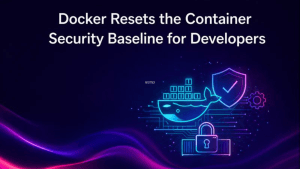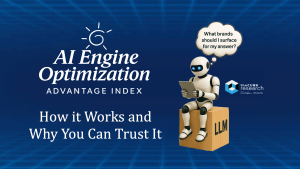- Cloud computing has been the single most transformative force in IT over the last decade – what will Cloud 2030 look like? As we enter the 2020s, we believe that cloud will become the underpinning of a ubiquitous, intelligent and autonomous resource that will disrupt the operational stacks of virtually every company in all industries.
This Breaking Analysis is a special report as part of theCUBE ’s coverage of AWS re:Invent 2020. In this post, we’ll put forth our scenario for the next decade of cloud evolution. In addition, we will share our latest market figures for the big 3 hyperscalers and drill into the most recent data on AWS from ETR’s October 2020 survey of more than 1,400 CIOs and IT buyers.
Cloud Computing: 2006 – 2020
Where did we come from and where are we going? The graphic below shows our view of the critical inflection points that catalyzed cloud adoption, In the middle of the 2000’s, the IT industry was recovering from the shock of the dot.com bubble and 9/11. CIOs were still licking their wounds from the narrative, that IT doesn’t matter. In 2006, AWS launched its Simple Storage Service and later EC2, with little fanfare. But developers at startups and small businesses noticed and over night, AWS turned the data center into an API.
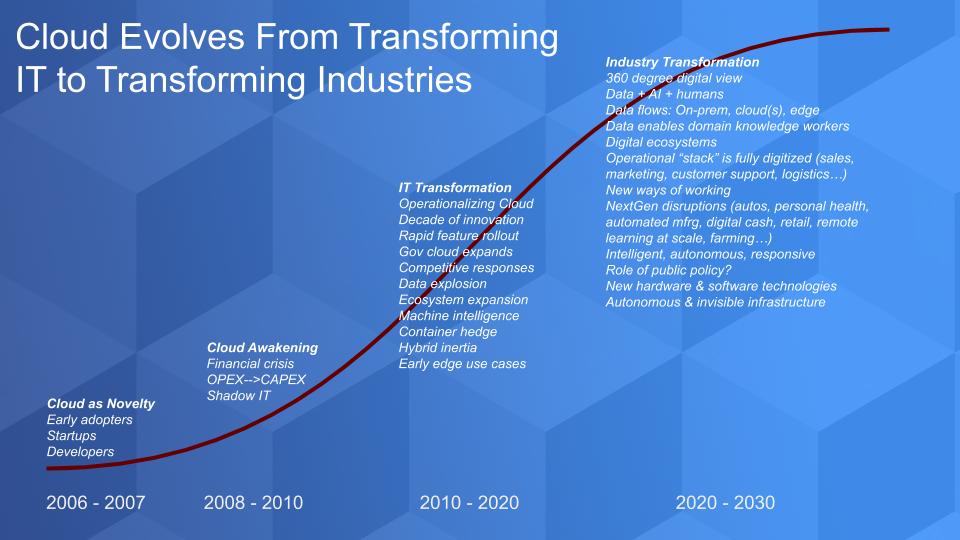
Analysts like us saw the writing on the wall as CEO after CEO poo poo’d Amazon’s entrance into their territory. They said things like “you guys have all gone cloud crazy…it’s all you want to talk about.” And “we’re doing just fine.” Many promised a cloud strategy that would allow them to easily defend their respective turves. We’d seen the industry in denial before with phrases like “PCs are toys” and “Unix is snake oil.”
The financial crisis was a boon for the cloud. CFOs saw a way to conserve cash, shift CAPEX to OPEX and avoid getting locked in to long term capital depreciation schedules or constrictive leases. We also saw shadow IT take hold and bleed into the 2010s in a big way.
This of course created problems for organizations, rightly concerned about security and rogue tech projects. CIOs were asked to clean up the crime scene and in doing so realized the inevitable– i.e. that they could transform their IT operational models, shift infrastructure management to more strategic initiatives and drop money to the bottom lines of their businesses.
The 2010s were an era of rapid innovation and a level of data explosion that we’d not seen before. AWS led the charge with a torrent pace of innovation via feature rollouts. Virtually every industry, including the all-important public sector got into the act, again led by AWS with the seminal CIA deal. Google got in the game early but never took the enterprise business seriously until 2015 when it hired Diane Greene. But Microsoft saw the opportunity and leaned in and made remarkable strides in the second half of the decade leveraging its massive software estate.
The 2010s also saw the rapid adoption of containers and an exit from the long AI winter, which along with the data explosion created new workloads began to go mainstream. During this decade we saw hybrid investments begin to show some promise as the ecosystem realized broadly that it had to play in the AWS sandbox or it would lose customers. And we saw the emergence of edge and IoT use cases like AWS’ Ground Station emerge.
The Next Decade of Cloud will be Different
The question is…what’s next.
Whereas the last decade was largely about shifting the heavy burden of IT infrastructure management to the cloud, in the coming decade, we see the emergence of a true digital revolution. Most people agree that COVID has accelerated this shift by at least 2-3 years. We see all industries as ripe for disruption as they create a 360 degree view across their operational stack. Meaning sales, marketing, customer service, logistics, etc., are unified such that the customer experience is unified.
We see data flows as unified as well where domain-specific knowledge workers are first party citizens in the data pipeline, not subservient to hyper-specialized technology experts.
No industry is safe from this disruption and the pandemic has given us a glimpse of the future. Health care is going increasingly remote and becoming personalized. Machines are making more accurate diagnoses than humans in some cases. Manufacturing will see new levels of automation. Digital cash, blockchain and new payment systems will challenge traditional banking norms. Retail has been completely disrupted in the last nine months. As has education. And we’re seeing the rise of Tesla as a possible harbinger to a day where owning and driving your own vehicle could become the exception rather than the norm. Farming, insurance..on and on…virtually every industry will be transformed as this intelligent, responsive, autonomous, hyper-distributed system provides services that are ubiquitous and largely invisible.
Several Questions Remain
First you may ask – “is this even cloud that you’re talking about?” And that’s understandable. We would argue that the definition of cloud is evolving and expanding. Cloud has defined the consumption model for technology. You see cloud-like pricing models moving on-prem with initiatives like HPE’s GreenLake and now Dell’s APEX. SaaS pricing is evolving and you see companies like Snowflake and Datadog challenging traditional SaaS models with true cloud consumption pricing and we think this will become the norm.
As hybrid cloud emerges and pushes to the edge the cloud becomes a hyper-distributed system with a deployment and programming model that becomes much more uniform and ubiquitous. So maybe this S-Curve we’ve drawn needs an adjacent curve with a steeper vertical this decade. And perhaps the nomenclature evolves but we believe that cloud will be the underpinning of whatever we call the future platform.
We also point out on the chart above that public policy will evolve to address privacy and industry power concerns and that will vary by region. So we don’t expect the big “techlash” to abate in the coming years.
And finally we definitely see alternative hardware and software models emerging as witnessed by NVIDIA and ARM, DPUs from companies like Fungible and AWS, and others, designing their own silicon for specific workloads, control their costs and reduce their reliance on Intel.
So the bottom line is that we see programming models evolving from infrastructure-as-code to programmable digital businesses…where ecosystems power the next wave of data creation, data sharing and innovation.
Cloud Market Shares for 2020 – AWS Continues to Lead
The chart below shows a just released update of our IaaS and PaaS revenue for the Big 3 cloud players, AWS, Azure and Google.
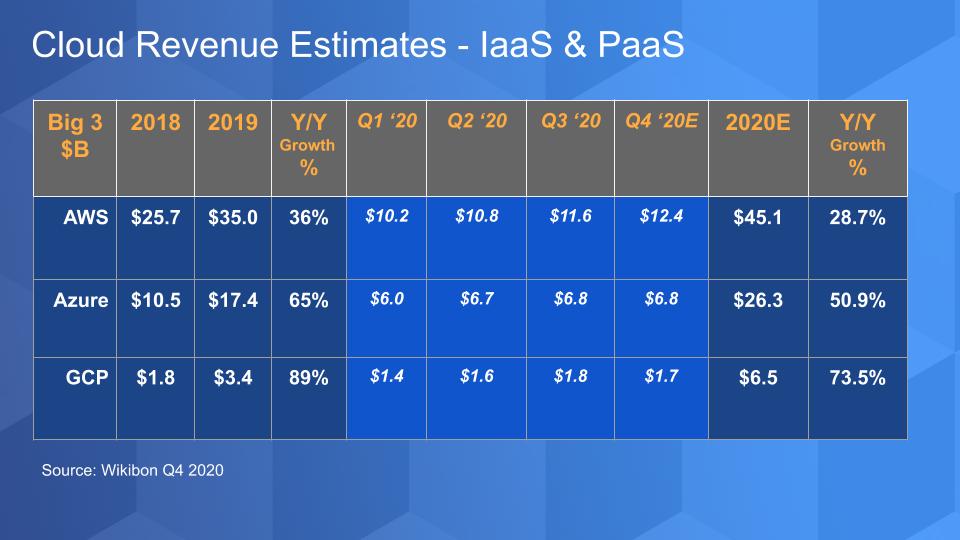
And you can see we’ve estimated Q4 revenues or each player and the full year 2020. Please remember our normal caveats on this data – AWS reports clean numbers whereas Azure and GCP are estimates based on breadcrumbs each company tosses our way. We triangulate using our own surveys, ETR data and theCUBE network data. The following points are worth noting:
- While AWS’ growth is lower than the other two, note what happens when the law of large numbers kicks in. Yes growth slows for AWS, but the absolute dollars are substantial and there’s nuance. For example, for AWS, Azure and Google, in Q4 2020 vs Q4 2019, we project annual quarter over quarter growth of 25%, 46% and 58% respectively. So meaningfully lower growth rates for AWS compared to the other two. Yet AWS’ revenue in absolute terms grows sequentially from Q3 to Q4 ($11.6B to $12.4B), whereas the others are flat to down sequentially. Azure and GCP will have to come in with substantially higher annual growth this quarter to increase revenue relative to Q3.
- Having said that, on an annual basis, both Azure and GCP are showing impressive growth in both percentage and absolute terms. AWS will add more than $10B to its revenue this year with Azure growing nearly $9B and GCP adding just over $3B. So there’s no denying that Azure is making ground as we’ve reported. GCP still has a long, long way to go.
- We also want to point out that these three companies alone now account for nearly $80B in infrastructure services annually. And the IaaS and PaaS business for these three companies combined is growing at around 40% annually. So much for repatriation…
A Drilldown into AWS’ Business Momentum
This wheel chart below shows how ETR calculates Net Score and its component parts.
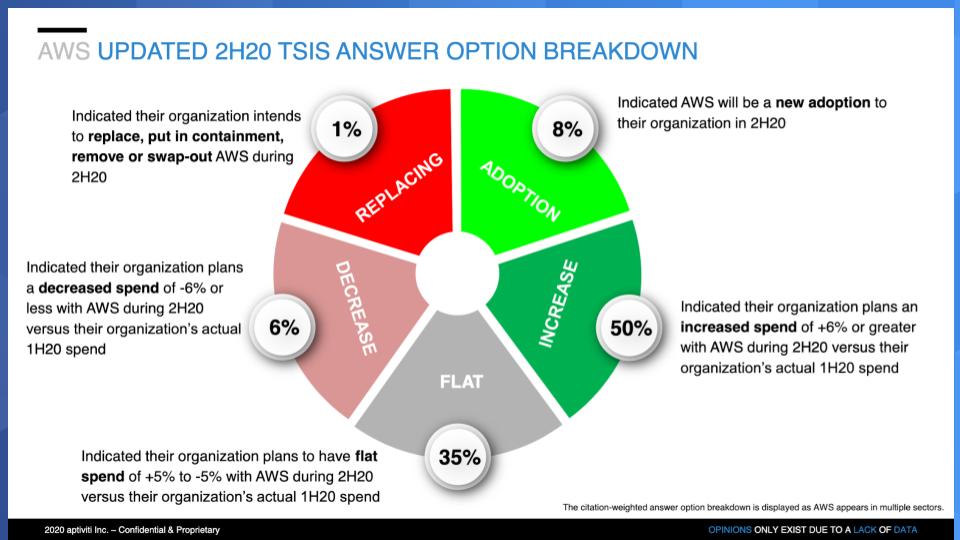
Each quarter ETR gets responses from thousands of CIOs and IT buyers and asks them; are you spending more or less on a particular platform or vendor. Net Score is derived by taking Adoption plus Increase and subtracting Decrease and Replacing – so subtracting the reds from the greens. Now remember – AWS is a $45B company and it has a Net Score of 51%. So despite its exposure to virtually every industry, including hospitality and airlines and other hard hit sectors, far more customers are spending more than less with AWS.
Where are Customers Spending in AWS’ Portfolio of Services
The chart below shows the Net Score across the AWS portfolio for three survey dates – last October (gray), this summer (blue) and the October 2020 survey (yellow).
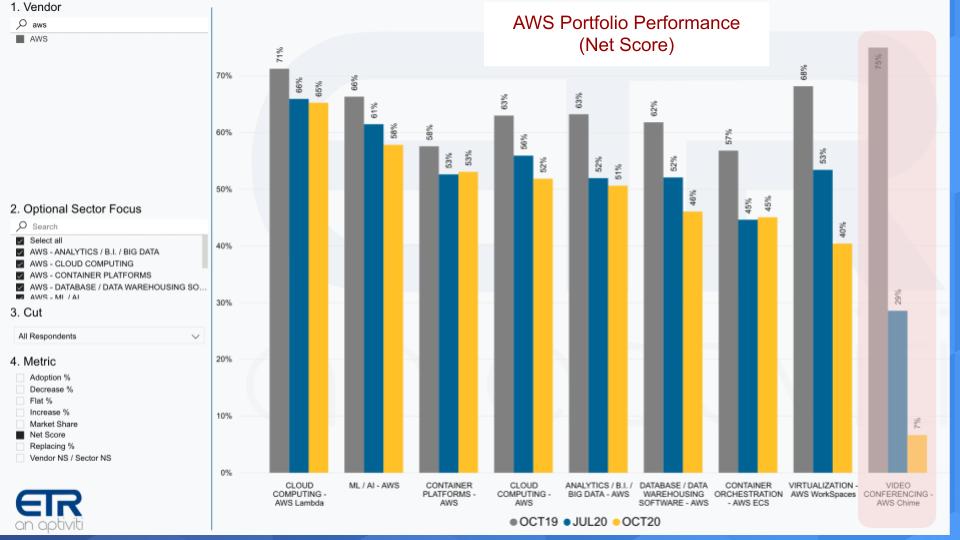
Remember, Net Score is an indicator of spending momentum and despite the deceleration as shown in the yellow these are very elevated Net Scores. Only Chime video conferencing is showing notable weakness in the AWS data set from the ETR survey with an anemic 7% Net Score.
But every other sector has elevated spending scores. Starting with Lambda on the left hand side you can see a 65% Net Score. For context, very few companies have Net Scores that high. Snowflake and Kubernetes spend are two examples with higher Net Scores but this is rarefied air space for AWS functions.
Similarly, you can see, AI, containers, cloud overall and analytics all over 50% Net Score. Now, while database is still elevated with a 46% Net Score it’s come down from its highs as of late. Perhaps because AWS has so many options in its own portfolio and the survey doesn’t have enough granularity. But there is competition as well.
On balancer, this is a very strong portfolio from a spending momentum standpoint.
The Flip Side: Very Low Defections off the AWS Cloud
We find the data below to be very impressive. The chart shows the same portfolio view but isolates on the bright red portion of the wheel – i.e. replacements.
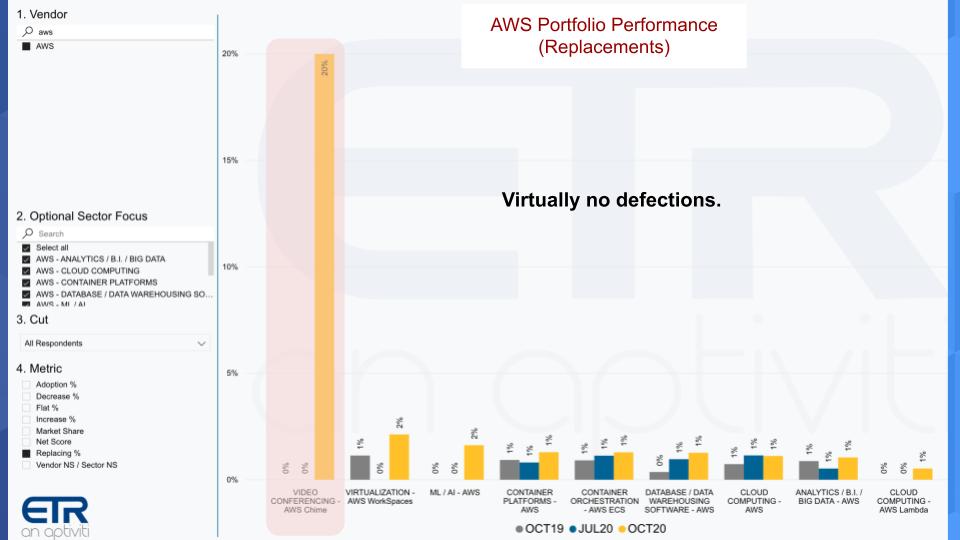
Basically, very few defections show up for AWS in the ETR survey. Again, only Chime is a sore spot but everywhere else in the portfolio we’re seeing low single digit replacements.
The Cloud Competitive Landscape
We’ve shown the chart below in previous Breaking Analysis segments. It plots Net Score or spending velocity on the vertical axis and Market Share, which measures pervasiveness in the data set, on the horizontal axis. And in the table portion – upper right corner, you can see the numbers that drive the positions of each company.
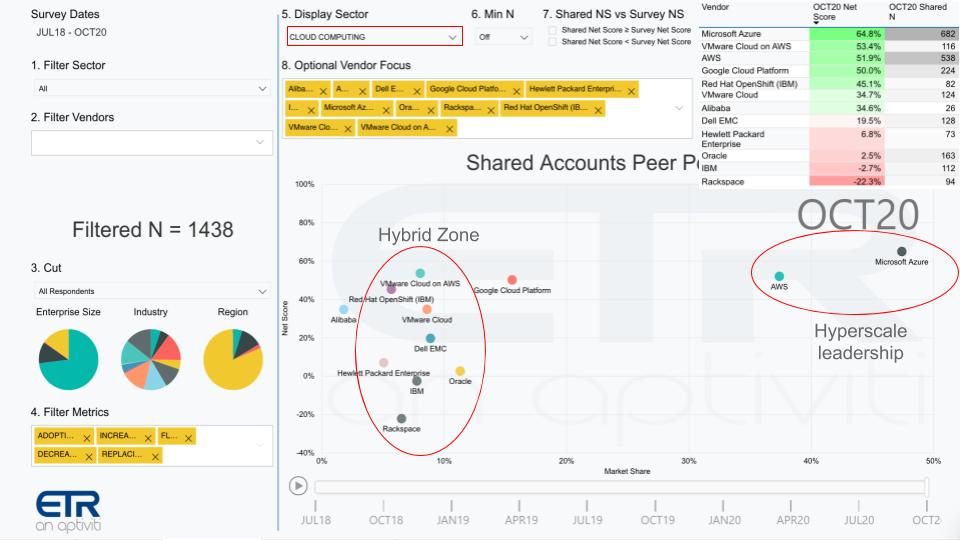
As you can see the data confirms what we know – this is a two horse race right now between AWS and Microsoft. Google is hanging out with the on-prem crowd, vying for relevance in the data center. We’ve talked extensively about how we would like to see Google evolve its business and rely less on appropriating data to serve ads…and focus more on cloud. There’s so much opportunity there.
But nonetheless, you see the so-called hybrid zone emerging. Hybrid is real. Customers want hybrid and AWS is going to have to learn how to support hybrid deployments with offerings like Outposts and others. But the data doesn’t lie. The foundation has been set for the 2020’s and AWS is very well positioned to maintain its leadership position.
What do Customers Say about AWS?
The quotes below were pulled from several ETR VENN roundtables this year.
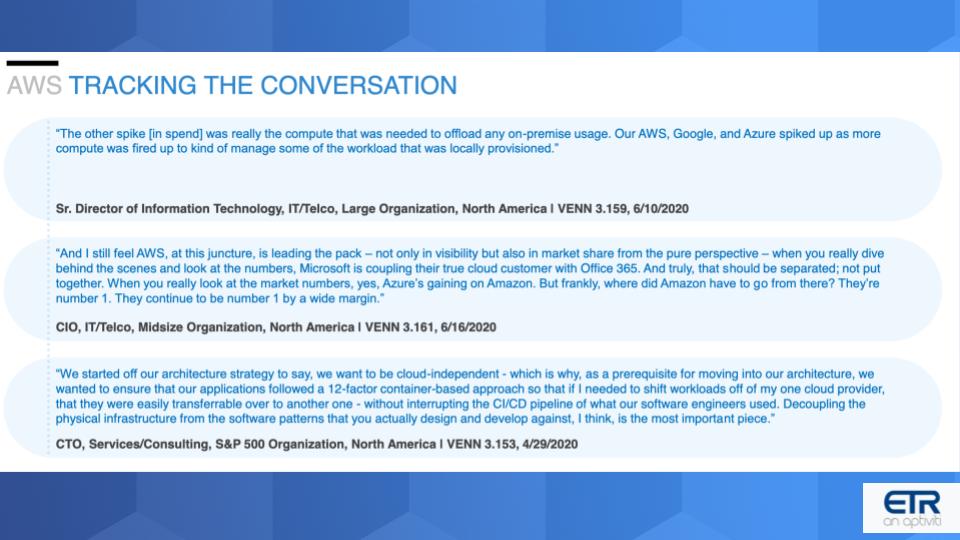
The Compute Bill. The first comment speaks to the cloud compute bill. It spikes and sometimes can be unpredictable.
AWS Leadership. The second comment is from a CIO at a telco who says (we’ll paraphrase):
AWS is leading the pack and is number one …and AWS will continue to be number one by a wide margin.
Multicloud. The third quote is from a CTO at an S&P 500 organization who sees the importance of cloud independence as an architectural and strategic mandate. The central concern of this person is the software engineering pipeline. The strategy is to clearly go multi-cloud to avoid getting locked in an ensuring that developers can be productive, independent of the cloud platform. Essentially separating the underlying infrastructure from software development.
Summarizing Cloud 2030
We talked about how the cloud will evolve to become an even more hyper-distributed system that can sense, act and serve…providing sets of intelligent services on which digital businesses will be constructed and transformed.
We expect AWS to continue to lead in this build out with its heritage of delivering innovations and features at a torrid pace.
We believe that ecosystems will become the mainspring of innovation in the coming decade and we feel that AWS has to embrace not only hybrid, but cross cloud services. And it has to be careful not to push its ecosystem partners to competitors…it has to walk a fine line between competing and nurturing its partners. To date, its success has been a key to that balance as AWS has been able to, for the most part, call the shots. However we shall see if competition and public policy attenuate its dominant position in this regard.
What will be fascinating to watch is how AWS behaves given its famed customer obsession. And how it decodes customer needs. As Steve Jobs famously said:
Some people say give the customers what they want, but that’s not my approach. Our job is to figure out what they’re going to want before they do. I think Henry Ford once said, ‘If I’d ask customers what they wanted, they would’ve told me a faster horse.’
Remember these episodes are all available as podcasts – please subscribe. We publish weekly on Wikibon.com and Siliconangle.com so check that out and please do comment on the LinkedIn posts we publish. Don’t forget to check out ETR for all the survey data. Get in touch on twitter @dvellante or email david.vellante@siliconangle.com. And remember, Breaking Analysis posts, videos and podcasts are all available at the top link on the Wikibon.com home page.
Thanks everyone, be well and we will see you next time.
Watch the full video analysis:
Photo credit: ATKWORK888


